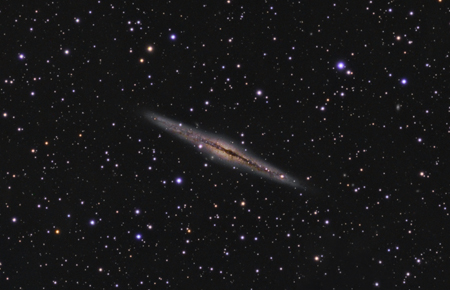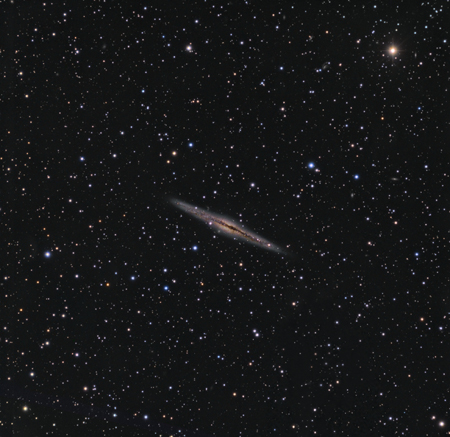NGC 891 in Andromeda is one of the most photogenic edge-on spirals around and about 30 million light years away.
I find it fascinating finding out what sort of planet Earth was when
the light left these objects we view, so here's a brief synopsis.
We are looking at light that left near the start of the Oligocene epoch,
the time of the transition between the tropical Eocene and the more modern
ecosystems of the following Miocene.
This is the time when grasslands, and the associated grazing animals were
spreading, and the tropical forests were becoming limited to the equatorial
belts.
The planet was getting cooler and more seasonal, and in Europe, the Alps
were rising as the African landmass continued to push northwards.
There was also a major extinction event, where Asian fauna replaced the
previous European fauna.
Some species of terrestrial mammals returned to the oceans about this
time. Amongst these were the ancestors of the dolphins.
I was amazed how many galaxies are in the background in this shot….it's
full of them, individually and in clusters.
This image is was the first successful image done using my dual scope imaging rig, and I'm pleased with the way it's come together. Over 10 hours of data gathered in a little over 5 hours. Very handy in our climate!
I used my TMB 152 @ F8 and SXVF-H16 camera to capture the luminance,
and my William Optics ZS80FD and Atik 16HR for the RGB.
The 16HR data was then rescaled using Registar, and the data combined
with the luminance in the usual way.
Luminance 31 x 10 minutes
Red 17 x 4 minutes
Green 22 x 5 minutes
Blue 19 x 7 minutes.
Total imaging time. 10 hrs 21 minutes.

